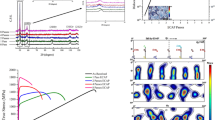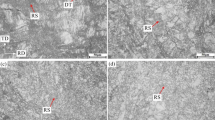We study the effects of extrusion treatment with subsequent rolling in combination with annealing, changes in the direction of rolling after each pass (original sheet), and alternating bending (AB) for 0.5; 1; 3, and 5 cycles, as well as the effect of texture on the parameter of damage D and the elastic and mechanical properties of the material in uniaxial tensile tests (ultimate strength σu, yield point σ0.2, and relative elongation Δl/l) for the ZE10 magnesium alloy with zinc, zirconium, and rare-earth metals. We determined the values of damage parameters according to the changes in the modulus of elasticity after the corresponding number of AB cycles relative to its values in different directions for the original analyzed sheet. Note that the damage parameters were computed by using the models of equivalent strains and equivalent elastic energy. It is established that the elasticity moduli, ultimate strengths, conventional yield points, and relative elongations averaged over all directions in the sheets of the alloy, decrease and, on the contrary, the corresponding values of damage parameters increase with the number of AB cycles and obey parabolic laws, as follows from the correlation and regression analyses. The anisotropy of indicated characteristics also weakens under the conditions of alternating bending. It was also shown that there exist strong correlation relations between the Kearns texture parameters, on the one hand, and the moduli of elasticity, damage parameters, ultimate strengths, yield points, and relative elongation, on the other hand. We deduce the corresponding quadratic regression equations with high values of the reliability index of approximation. It was also shown that the indicated changes in the analyzed properties are mainly caused by the variations of crystallographic textures.

Similar content being viewed by others
References
Z. Yang, J. P. Li, J. X. Zhang, G. W. Lorimer, and J. Robson, “Review on research and development of magnesium alloys,” Acta Metallurg. Sinica, 21, No. 5, 313–328 (2008); URL: https://www.sciencedirect.com/science/article/abs/pii/S100671910860054X.
R. Li, F. Pan, B. Jiang, H. Dong, and Q. Yang, “Effect of Li addition on the mechanical behavior and texture of the as-extruded AZ31 magnesium alloy,” Mater. Sci. Eng., Ser.: A, 562, No. 1, 33–38 (2013); URL: 10.1016/j.msea.2012.11.032.
K. K. Alaneme and E. A. Okolete, “Enhancing plastic deformability of Mg and its alloys—A review of traditional and nascent developments,” J. Magnesium Alloy, 5, No. 4, 460–475 (2017); URL: 10.1016/j.jma.2017.11.001.
R. K. Mishra, A. K. Gupta, P. R. Rao, A. K. Sachdev, A. M. Kumar, and A. A. Luo, “Influence of cerium on the texture and ductility of magnesium extrusions,” Scripta Mater., 59, No. 5, 562–565 (2008); URL: https://www.sciencedirect.com/science/article/ pii/S135964620800362X.
L. W. F. Mackenzie and M. O. Pekguleryuz, “The recrystallization and texture of magnesium–zinc–cerium alloys,” Scripta Mater., 59, No. 6, 665–668. (2008); URL: https://www.sciencedirect.com/science/article/pii/S1359646208003874.
N. Stanford and M. Barnett, “Effect of composition on the texture and deformation behavior of wrought Mg alloys,” Scripta Mater., 58, No. 3, 179–182 (2008); URL: https://www.sciencedirect.com/science/article/pii/S1359646207006938.
J. D. Robson, “Critical assessment 9: Wrought magnesium alloys,” Mater. Sci. Technol., 31, No. 3, 257–264 (2015); URL: https:// doi.org/10.1179/1743284714Y.0000000683.
Methods of Leveling Sheet Metal, ARKU Magazine; URL: https://www.arku.com/us/arku-magazine/detail/sheet-metal-leveling-methods-us/.
N. M. Shkatulyak, V. V. Usov, N. A. Volchok, A. A. Bryukhanov, S. V. San’kova, M. Rodman, M. Shaper, and C. Klose, “Effect of reverse bending on texture, structure, and mechanical properties of sheets of magnesium alloys with zinc and zirconium,” Phys. Metals Metallogr., 115, No. 6, 609–616 (2014); URL: https://link.springer.com/article/10.1134/S0031918X1406012X.
L. M. Kachanov, Foundations of Fracture Mechanics [in Russian], Nauka, Moscow (1974).
Yu. N. Rabotnov, Selected Works [in Russian], Nauka, Moscow (1991).
J. Lemaitre and R. Desmorat, “Anisotropic damage law of evolution,” Eur. J. Mech. A/Solids, 19, No. 2, 187–208 (2000); URL: https://www.sciencedirect.com/science/article/pii/S0997753800001613.
N. R. Hansen and H. L. Schreyer, “A thermodynamically consistent framework for theories of elastoplasticity coupled with damage,” Int. J. Solid. Struct., 31, No. 3, 359–389 (1994); URL: 10.1016/0020-7683(94)90112-0.
C. L. Chow and J. Wang, “An anisotropic theory of elasticity for continuum damage mechanics,” Int. J. Fract., 33, No. 1, 3–16 (1987); URL: https://link.springer.com/article/10.1007/BF00034895.
M. Bobyr O. Khalimon, and O. Bondarets, “Phenomenological damage models of anisotropic structural materials,” J. Mech. Eng. NTUU “Kyiv Polytechnic Institute,” No. 67, 5–13 (2013); URL: http://nbuv.gov.ua/UJRN/VKPI_mash_2013_67_3.
V. V. Usov and N. M. Shkatulyak, “Fractal nature of the dislocation structure of low-alloyed steel after controlled rolling,” Russ. Phys. J., 47, No. 11, 1139–1146 (2004); URL: https://link.springer.com/article/10.1007/s11182-005-0044-y.
WIPO Patent Application WO/2011/146970; URL: http://www.sumobrain.com/patents/ wipo/Magnesium-based-alloy-wrought-applications/WO2011146970A1.html.
P. R. Morris, “Reducing the effects of nonuniform pole distribution in inverse pole figure studies,” J. Appl. Phys., 30, No. 4, 595–596 (1959); URL: 10.1063/1.1702413.
J. J. Kearns, Thermal Expansion and Preferred Orientation in Zircaloy; URL: https://ntrl.ntis.gov/NTRL/dashboard/searchResults/ titleDetail/WAPDTM472.xhtml.
Ya. D. Vishnyakov, A. A. Babareko, S. A. Vladimirov, and I. V. Egiz, Theory of Texture Formation in Metals and Alloys [in Russian], Nauka, Moscow (1979).
L. I. Mirkin, Handbook on X-ray Diffraction Analysis of Polycrystals [in Russian], Fizmatgiz, Moscow (1961.
Y. Liu, W. Li, and Y. Li, “Microstructure and mechanical properties of ZE10 magnesium alloy prepared by equal channel angular pressing,” Int. J. Minerals, Metallurgy, Mater., 16, No. 5, 559–563 (2009); URL: 10.1016/S1674-4799(09)60096-0.
V. Grytsyna, D. Malykhin, T. Yurkova, K. Kovtun, T. Chernyayeva, G. Kovtun, I. Tantsura, and V. Voyevodin, “On structural aspects of texture changes during rolling of Zr–2.5% Nb alloy,” East Eur. J. Phys., No. 3, 38–45 (2019); URL: 10.26565/2312-4334-2019-3-05.
Author information
Authors and Affiliations
Corresponding author
Additional information
Translated from Fizyko-Khimichna Mekhanika Materialiv, Vol. 56, No. 6, pp. 65–75, November–December, 2020.
Rights and permissions
About this article
Cite this article
Usov, V.V., Shkatulyak, N.М., Savchuk, O.S. et al. Influence of the Type of Deformation and Texture on the Damageability and Mechanical Properties of ZE10 Magnesium Alloy. Mater Sci 56, 795–806 (2021). https://doi.org/10.1007/s11003-021-00497-3
Received:
Published:
Issue Date:
DOI: https://doi.org/10.1007/s11003-021-00497-3




